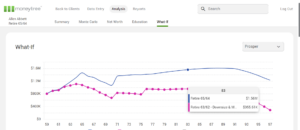Monte Carlo.
It’s a district in Monaco. It’s perhaps the world’s most famous casino. It’s a two-door Chevrolet car that went out of production in 2007.
And, it’s one of the ways Moneytree software rises above the competition.
Moneytree’s Monte Carlo simulator ranked No. 1 in the Kitces Report, Volume 1, 2023, with a client satisfaction rating of 9.1, outpacing eMoney, Moneyguide, and RightCapital.
The reason we rank so high is simple. We outwork our competition.
While most our competitors top out at 1,000 simulation trials in their Monte Carlo, Moneytree runs 10,000. That means that clients can have even more confidence in their retirement, knowing that the plan you created for them has been stress-tested against 10,000 scenarios.
“There is credence and value to running that many simulations,” Moneytree Product Manager and former financial advisor Matt Garrett said. “One-thousand seems like a lot, but in the grand scheme of things, it really isn’t. So, offering 10,000 simulations is about having confidence in the numbers and confidence that your client can retire successfully.”
Des Moines-based financial advisor Jay Ennis, RICP, ChFC, ChFEBC, of Focus Financial agreed.
According to Ennis, the real value in the additional simulations is that it generates a lot more “outlier” trials that help identify potential weaknesses better than a smaller sampling would.
“And it’s those bad outliers that you are trying to guard against for your clients,” he said.
What is Monte Carlo?
The Monte Carlo method is a statistical technique that uses random sampling to simulate and analyze complex systems and project possible futures. It was first developed in the 1940s during the Manhattan Project, a research project that produced the first nuclear weapons.
Stanislaw Ulam, a mathematician who was working on the project, along with John von Neumann, another mathematician and physicist, proposed using random sampling to simulate the behavior of neutrons in a nuclear reactor. This led to the development of the Monte Carlo method, which was named after the Monte Carlo Casino in Monaco, where Ulam’s uncle liked to gamble.
Monte Carlo recently gained popularity among financial planners because of its flexibility and ability to produce complex models quickly. You can use Monte Carlo methods for everything from calculating retirement income projections or determining optimal asset allocations for clients’ portfolios.
Ennis remembers first seeing Monte Carlo in the financial services industry in the late 1990s.
“I got into this business because I wanted to have a positive impact on people’s lives,” Ennis said. “As a tool, Monte Carlo helps me do that. It really is a stress test. If these numbers aren’t good, we are going to have to think of other strategies. Clients get it. They really understand.”
Monte Carlo simulations are based on historical data and use statistical techniques such as regression analysis to forecast outcomes over time. While these calculations do not guarantee accuracy, they give investors an idea of what might happen if certain events occur or conditions change in the future.
The Monte Carlo method also provides visual representations of data through graphs that show how sensitive your forecasts are to changes in input assumptions (or “parameters”). This helps you understand the range of outcomes that could result from changing those assumptions over time–for example, if interest rates rise or fall by 1%, what would happen?
It’s difficult to determine exactly how many financial advisors and planners use Monte Carlo simulations as there is no central repository that tracks this information. However, Monte Carlo simulations have become increasingly popular, and many financial advisors and planners now use them as a tool to help clients make more informed investment decisions.
About Moneytree’s Monte Carlo
Moneytree was an early adopter of Monte Carlo, and the tool aligned perfectly with the company’s longstanding goal to provide top-tier statistical analysis.
Furthermore, Moneytree’s Monte Carlo tool is available in all product packages, from basic to advanced, desktop to online. So, no matter what version of Moneytree you use, you get the industry leading Monte Carlo simulator.
Moneytree’s in-depth Monte Carlo is one of the primary reasons Bill Hampton chose the software provider in 2020. Hampton is CEO of Hampton Tax and Financial Services LLC in Atlanta, Georgia. He credits Moneytree’s Monte Carlo with helping him strengthen relationships with clients.
“I love it, and my clients love it,” he said. “The response has been great.”
Moneytree’s Monte Carlo generates a “cyclone chart” that shows 200 to 300 representative simulations, because showing all 10,000 would be overwhelming visually.
Here is some useful information about our specific Monte Carlo calculations.
- Our Monte Carlo evaluates potential fluctuations in any assets that can be readily used to fund spending needs, which we typically refer to as Retirement Capital.
- In Moneytree Plan, you can enter custom rates of return for individual accounts/assets, or apply defaults. That data is then compiled to create an overall weighted average rate of return for a given tax category.
- The standard deviation can either be manually defined for the user, or calculated. The calculated standard deviation will be based off the overall current weighted average portfolio return across all assets used to fund retirement.
- Randomization is applied to any and all assets available to fund spending. It does not matter if an asset is projected separately, or a custom return is entered, or if future rate changes are applied.
- Randomization is not applied to any assets outside of capital, such as businesses, real estate, or personal property. Once sold, it will be reinvested into balances that would be subject to randomization.
Get in touch
Monte Carlo is a powerful tool for financial planning. It can provide more accurate and comprehensive forecasts, allowing you to make better decisions about your finances.
If you’re looking for financial planning software with a powerful Monte Carlo tool, check us out today.
The projections or other information generated by Monte Carlo Analysis tools regarding the likelihood of various investment outcomes are hypothetical in nature, do not reflect actual investment results, and are not guarantees of future results. Results may vary with each use and over time.
Securities offered through Royal Alliance Associates, Inc., member FINRA/SIPC. Insurance and investment advisory services offered through Focus Financial. RAA is separately owned and other entities and/or marketing names, products or services referenced here are independent of RAA.




